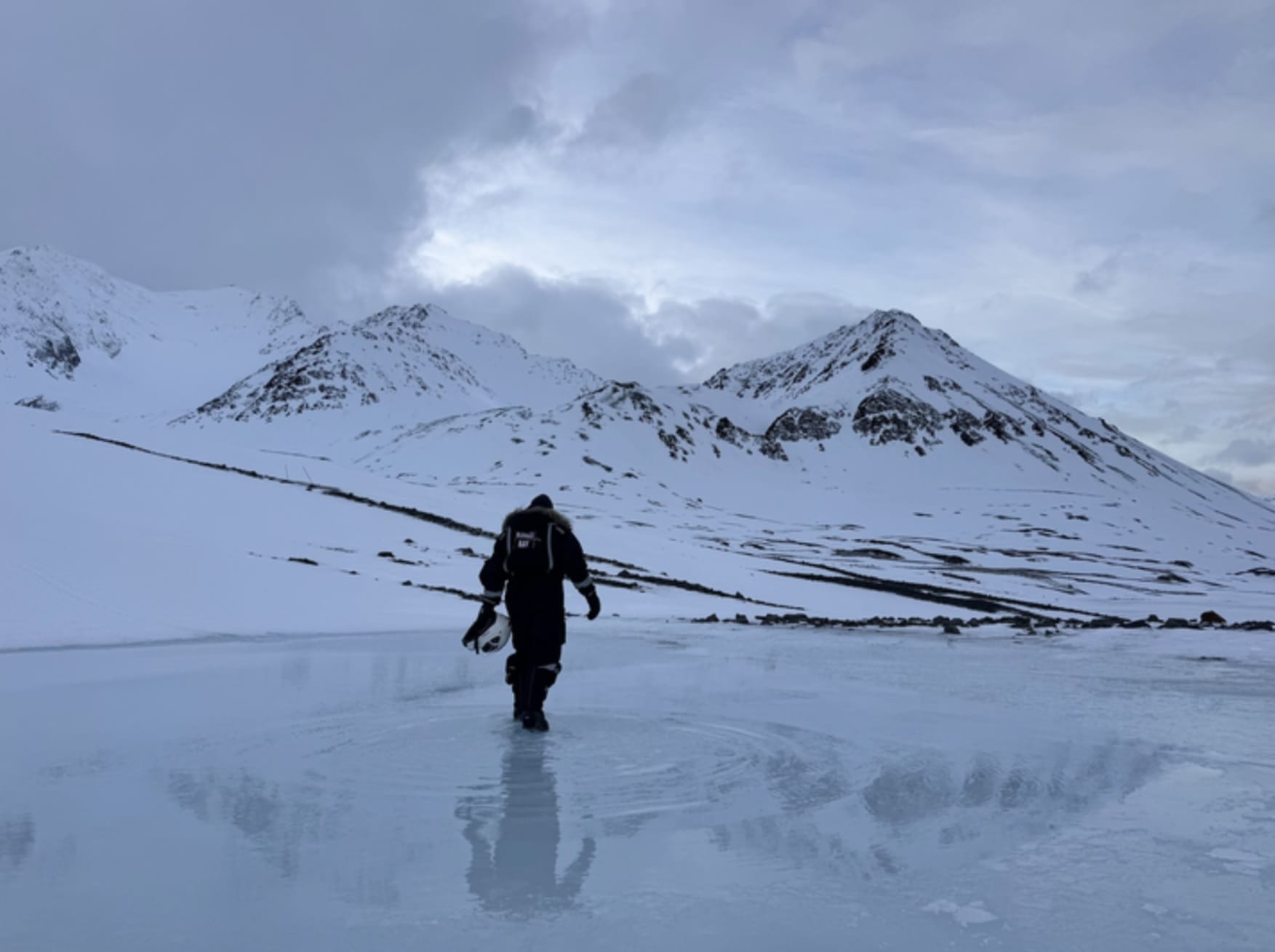Welcome back to the Abstract! Here are the climate warnings, cosmic apocalypses, and wolf tales that made an impression on me this week.
First, a dispatch from the northernmost settlement on Earth, where climate warming is completely reshaping the landscape. Then: a case of star-crossed companions, encounters with globular clusters, and some trophic cascades as a treat.
“Unseasonably warm” hits differently in Svalbard
Bradley, James et al. “Svalbard winter warming is reaching melting point.” Nature Communications.
Science journals are constantly packed with new alarms about human-driven climate change, but one dispatch in particular stood out to me this week. The authors report a freakish warm spell that occurred in Svalbard, a Norwegian Arctic archipelago, in February 2025, and include surreal accounts of how the normally frozen research outpost turned into a “melting ice rink,” according to the study.
“Svalbard is at the front line of the climate crisis, warming at six to seven times the global average rate,” said researchers led by James Bradley of Queen Mary University of London.
“Our winter-time field campaigns in Svalbard are conducted under the expectation of sub-zero temperatures and extensive snow cover—conditions that have historically been typical in Svalbard during winter,” the team continued. “However, in February 2025, we encountered air temperatures persistently above 0°C, as well as rainfall, exceptionally low snow cover, and pooling meltwater covering the tundra.”
Bradley and his colleagues were based around Ny-Ålesund, the world’s northernmost permanent settlement, which is about 750 miles from the North Pole. From 1961 to 2001, the town’s average air temperature in February hovered around -15°C (or 5°F). In February 2025, the average was -3.3°C (26°F), with the hottest day reaching 4.7°C (40°F).
All of us are now living with the effects of climate change, but the authors document the dizzying pace of change in this polar community and cite tangible differences as their familiar research haunt thaws out.
“Vegetation emerged through the melting snow and ice, displaying green hues typically associated with spring and summer,” the team said. “Blooms of biological activity were widespread across the thawing tundra. Surface soils, which are typically frozen solid during this time of the year, thawed such that they were soft enough to be directly sampled with a spoon, rather than digging snow pits to the soil surface and using drills and pickaxes to extract frozen soil samples (which has been necessary during our normal wintertime sampling operations).”
The researchers also note that Arctic communities and infrastructure are reeling from the changes, which include an increased risk of avalanches and unstable snowpack. New foundations have been installed in many buildings, including the team’s research bases, to keep up with instabilities from thawing permafrost.
The team concludes with a sentiment that is becoming more common in this field: It may be worse than we think. It’s not an uplifting thought, but one that should be confronted, especially since few people are able to travel to these remote communities to experience the changes for themselves.
“The thaw event of February 2025 was not an isolated occurrence,” the team warned. “Witnessing it in real time served as a reminder of the accelerating pace of change, and made us wonder if we have been too cautious with our climate warnings.”
In other news…
First sighting of the Betelbuddy
Betelgeuse, the supergiant star on Orion’s left shoulder, may have a Betelbuddy. Astronomers think they have directly spotted Betelgeuse’s companion star, provisionally called Alpha Ori B, which orbits the senescent giant every six years and has been predicted for years.
We “report the likely direct-imaging detection of a stellar companion to Betelgeuse,” said researchers led by Steve Howell of NASA Ames Research Center, who captured the images with an instrument on Hawaii’s Gemini North telescope. “The results presented here are not definitive as the detection is at the limit of the instrument capabilities. However, the results do present the most direct and substantive evidence for the existence of a stellar companion to Betelgeuse, as well as the properties of that companion.”
Betelgeuse’s wild variations in radiance, especially the so-called Great Dimming of 2020, are seen by some stargazers as heralds of imminent supernova explosion. Astronomers ultimately showed that the Great Dimming was just some dust coughed out by the dying giant, but Betelgeuse could still blow at any time—and when it does, it will take its companion down with it.
Left alone, Alpha Ori B would mature into a main-sequence star similar to our Sun, but “it will likely never arrive at that stage as Betelgeuse is predicted to produce a much-anticipated supernova in the coming millennia,” the study noted.
The perils of supergiant siblings! At least the new star might get a cool name before it's blown to bits. Since Betelgeuse means “the hand of the giant” in Arabic, the new study suggests naming the star “Siwarha,” or “her bracelet.” But considering the future in wait for the star, I’d say it's more a handcuff than a bracelet.
Watch your back for globular clusters
We move now from pyrotechnic stellar detonations to killer globular clusters. The universe is a dangerous place.
Using data from the Gaia telescope and next-generation simulations, scientists gamed out the probability that the Oort cloud, the spherical mass of icy bodies that surrounds our solar system, might be disrupted by passing globular clusters, which are clumps of stars wandering around the galaxy.
“We identified 35 globular clusters that could potentially experience close encounters with the Sun…throughout the Sun’s entire lifetime,” said the authors Maryna Ishchenko and Peter Berczik of the National Academy of Sciences of Ukraine. “Comet activity influenced by these interactions could disrupt ecosystems or pose threats to life.”
Even if these clusters passed more than a hundred light years from the Sun, they could still have a major effect, possibly nudging a slew of comets into the inner solar system that could pelt Earth and spark mass extinction events.
While it’s hair-raising to imagine marauding star blobs nudging death snowballs toward Earth, there is zero threat of such an encounter happening within our lifetimes, as no cluster is currently nearby. But it’s a helpful heads-up to flag for Earthlings in tens of millions of years, whatever shape they might take.
Wolves at the table help aspens become stable
Wolves continue to reshape Yellowstone National Park in the wake of their reintroduction to the historic range in the mid-1990s. During the long absence of the predators, which were wiped out by humans in this area by 1930, animals that would normally be wolf-chow, especially elk, spiraled ever upwards in numbers, putting pressure on many trees and plants.
Now, a study documents “the first new generation of overstory aspen trees in Yellowstone’s northern range in 80 years” mainly due to “increased predation [that] has caused a sustained reduction of elk numbers within the park, as well as changes in elk distribution, resulting in less browsing,” said researchers led by Luke Painter of Oregon State University.
New small trees are “present in 43 percent of stands and 22 percent of random plots in 2020–21, where none were found in 2012, beginning to replace an overstory in pronounced decline.”
“While a return to more extensive aspen stands will take time, and future conditions may not fully replicate the past, these new trees will help to ensure that aspen will persist into the future as a cornerstone of biodiversity in the northern Yellowstone landscape, and an example of widespread ecological change resulting from large carnivore restoration,” the team said.
To that end, movements to reintroduce carnivores—including bears, tigers, wolverines, and wolves—are ongoing around the world, in part because of observed ecosystem benefits. While these efforts must weigh risks to surrounding farms and communities, it is amazing to consider the far-reaching consequences that the 120-odd wolves that make up Yellowstone’s packs have had on its iconic landscape in just one generation.
Thanks for reading! See you next week.

